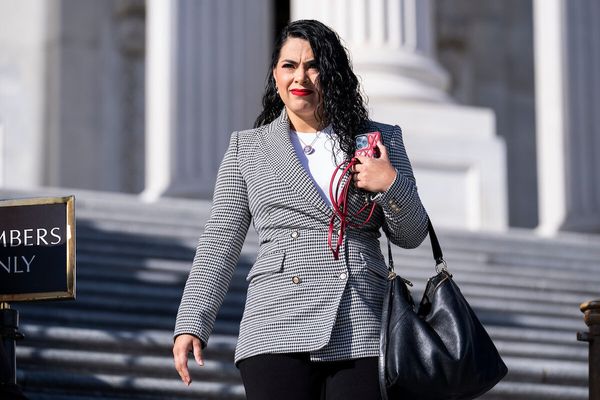
Truck horns blasted and red dust billowed beneath the blue Arizona sky as surplus army trucks sped up and down a road along the US-Mexico border, hauling shipping containers out of the Coronado national forest.
Piles of dirt and oak trees, bulldozed by construction crews, dotted the grassland of the San Rafael valley, south-east of Tucson, known as a vital wildlife corridor.
According to @DEMAArizona 1,700 shipping containers will be removed from the walls in Cochise County and Yuma that AZ Gov. @DougDucey built during his final months in office. The cost $76.5 million. I passed a few of them last week as I headed south to report on the removals. pic.twitter.com/AGeBxjFQwF
— Melissa del Bosque (@MelissaLaLinea) January 19, 2023
Former governor Doug Ducey had planned to build 10 miles of border “wall” made up of double-stacked old shipping containers through the federally protected forest.
But local residents and environmental groups occupied the construction site, running out the clock in December on Republican Ducey’s waning days in office.
Ducey, under threat of litigation from the Department of Justice, finally agreed to remove the rusty hulking barriers installed near Yuma in the west and Sierra Vista in the south-east of the state.
Environmentalists are now warning that the damage already done to the areas will require a huge recovery effort.
Erick Meza, borderlands coordinator for the environmental organization Sierra Club, said a lack of accountability over the project means more destruction.
“We just want to make sure that no further damage is done to the land due to the reckless operation of heavy machinery in a fragile desert ecosystem that will take decades to recuperate,” he told the Guardian this week.
Now two related lawsuits between Ducey and the federal government are on hold as Arizona’s new governor, Katie Hobbs, a Democrat, negotiates the project’s end.
In early January, approximately 130 shipping containers near Yuma came down in less than a week.
But the nearly 3.5 miles of barrier running across Coronado national forest land could take at least another month to dismantle, according to environmentalists monitoring the removal and damage.
On 3 January, the US Forest Service closed off the area, citing concerns over public health and safety. It did so as AshBritt, the Florida-based company that installed the makeshift wall, worked to remove it, outside the gaze of the public or the press.
Only five designated monitors from environmental groups, including the Sierra Club, the Wildlands Network and the Center for Biological Diversity, were allowed into the site, with permits issued by the US Forest Service.
The five set about documenting environmental damage and sharing videos, images and notes with Forest Service officials, who will be tasked with restoring the wildlife corridor.
It is one of the last on the Arizona border, where endangered jaguar, ocelots and other animals can migrate between Mexico and the US.
Late last week, however, the Forest Service canceled those permits, citing safety issues, according to monitors Erick Meza; Kate Scott, who runs the nonprofit Madrean Archipelago Wildlife Center; and Russ McSpadden, of the Center for Biological Diversity. They said they were approached by a law enforcement officer from the Forest Service, part of the Department of Agriculture, who said their permits were no longer authorized.
AshBritt continues to illegally damage Forest Service lands with new spur roads & damages to plants/wildlife during wall removal. The FS gave me a permit to document removal but earlier this week revoked it while I was in the field. A FS Ranger told me I was illegally on site... pic.twitter.com/CQxMP4QoiS
— Russ McSpadden (@PeccaryNotPig) January 15, 2023
The day before, Scott said, an armed security guard working for AshBritt had told her to leave. She showed him her permit and the guard, Scott recounted, told her it “didn’t mean shit to him” and warned her that “the Forest Service is coming to kick you out”.
Robin Silver, cofounder of the Arizona-based Center for Biological Diversity, said he believes the permits were canceled because of the environmental harm, and that the federal agency did nothing to stop the construction even though it was illegal.
“It’s highly embarrassing for the US Forest Service because of all of the damage that’s now being exposed,” he said.
The center filed two lawsuits against Ducey and AshBritt, citing violations of the federal Clean Water Act and the Endangered Species Act. The latter is now moot because the barrier is being removed, but the Clean Water Act lawsuit is still active, so ongoing monitoring is needed, Silver explained.
He added that damage done by excavators and trucks is “going to take a huge restoration effort”.
In August, Ducey cited an “invasion” at the border by migrants seeking haven in the US as the reason for granting AshBritt an emergency no-bid contract to install the containers.
Judy Kioski, public information officer for Arizona’s department of emergency and military affairs, said 1,700 shipping containers will now be removed at a cost of $76.5m. “The containers are being transported to state facilities in Yuma and Tucson until a plan for them is determined,” she said via email.
AshBritt’s original contract with the state included $123.6m to install the shipping container walls in Yuma and the Coronado national forest, and the company is now being paid to take them down.
The Florida-based disaster remediation firm has given millions to both Democratic and Republican campaigns. The company’s founder and director, Randal Perkins, paid a $125,000 fine in August 2021 for illegally donating $500,000 to the America First Action Super Pac, one of many fundraising political action committees supporting Donald Trump or Trump-like candidates.
At the time of the donation AshBritt had a $40m contract with the Department of Defense, and under federal law government contractors are prohibited from donating to political committees. Trump’s Super Pac refunded the money.
Meanwhile, sheriff David Hathaway of Santa Cruz county had refused to allow the shipping container barrier in his county, so Ducey turned to nextdoor – and sympathetic – Cochise county instead.
“They were violating the law by building on national forest land, they were tearing apart the hillsides,” Hathaway told the Guardian. “And it’s surprising to me that the federal government wasn’t willing to do anything about it. I told them if they entered my county to build it, I’d arrest them for illegal dumping.”
It’s unclear how much the federal government will have to spend to repair the environmental damage, or even if it will.
“What good are they [the Forest Service] if they’re not going to protect it? It’s still just us out here. We shut down the construction, and now we’re documenting the damage because no one else is,” said Scott.







